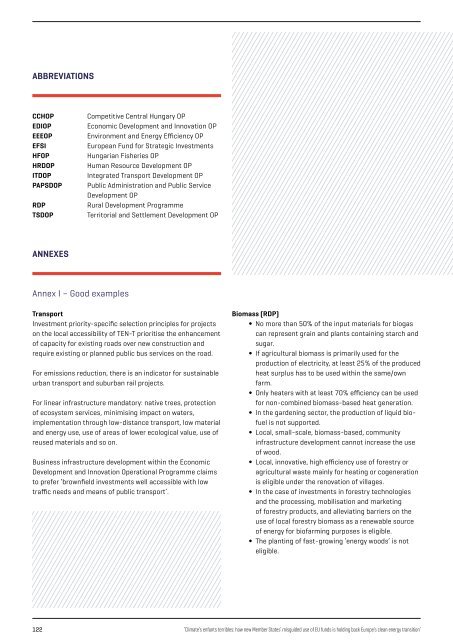ENFANTS TERRIBLES
enfants-terribles
enfants-terribles
Create successful ePaper yourself
Turn your PDF publications into a flip-book with our unique Google optimized e-Paper software.
ABBREVIATIONS<br />
CCHOP<br />
EDIOP<br />
EEEOP<br />
EFSI<br />
HFOP<br />
HRDOP<br />
ITDOP<br />
PAPSDOP<br />
RDP<br />
TSDOP<br />
Competitive Central Hungary OP<br />
Economic Development and Innovation OP<br />
Environment and Energy Efficiency OP<br />
European Fund for Strategic Investments<br />
Hungarian Fisheries OP<br />
Human Resource Development OP<br />
Integrated Transport Development OP<br />
Public Administration and Public Service<br />
Development OP<br />
Rural Development Programme<br />
Territorial and Settlement Development OP<br />
ANNEXES<br />
Annex I – Good examples<br />
Transport<br />
Investment priority-specific selection principles for projects<br />
on the local accessibility of TEN-T prioritise the enhancement<br />
of capacity for existing roads over new construction and<br />
require existing or planned public bus services on the road.<br />
For emissions reduction, there is an indicator for sustainable<br />
urban transport and suburban rail projects.<br />
For linear infrastructure mandatory: native trees, protection<br />
of ecosystem services, minimising impact on waters,<br />
implementation through low-distance transport, low material<br />
and energy use, use of areas of lower ecological value, use of<br />
reused materials and so on.<br />
Business infrastructure development within the Economic<br />
Development and Innovation Operational Programme claims<br />
to prefer ‘brownfield investments well accessible with low<br />
traffic needs and means of public transport’.<br />
Biomass (RDP)<br />
• No more than 50% of the input materials for biogas<br />
can represent grain and plants containing starch and<br />
sugar.<br />
• If agricultural biomass is primarily used for the<br />
production of electricity, at least 25% of the produced<br />
heat surplus has to be used within the same/own<br />
farm.<br />
• Only heaters with at least 70% efficiency can be used<br />
for non-combined biomass-based heat generation.<br />
• In the gardening sector, the production of liquid biofuel<br />
is not supported.<br />
• Local, small-scale, biomass-based, community<br />
infrastructure development cannot increase the use<br />
of wood.<br />
• Local, innovative, high efficiency use of forestry or<br />
agricultural waste mainly for heating or cogeneration<br />
is eligible under the renovation of villages.<br />
• In the case of investments in forestry technologies<br />
and the processing, mobilisation and marketing<br />
of forestry products, and alleviating barriers on the<br />
use of local forestry biomass as a renewable source<br />
of energy for biofarming purposes is eligible.<br />
• The planting of fast-growing ‘energy woods’ is not<br />
eligible.<br />
122<br />
‘Climate’s enfants terribles: how new Member States’ misguided use of EU funds is holding back Europe’s clean energy transition’


